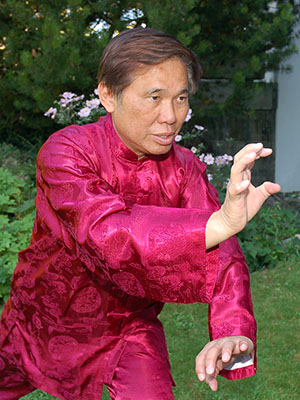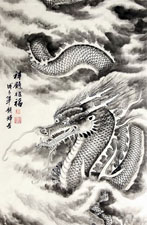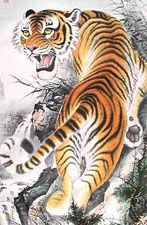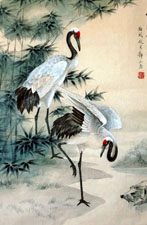THE MEANING OF CLASSICAL FIVE ANIMALS IN SHAOLIN KUNG FU
Sifu Leonard Lackinger, Shaolin Wabnam Austria

Hungry Tiger Snatches Goat
The five traditional animal styles of Shaolin Kung Fu are the dragon, the snake, the tiger, the leopard and the crane.
The following listings contain a brief description of the animals, their inner essence or spirit, physical characteristics (of the movements), corresponding Kung Fu techniques, typical Kung Fu sets and styles, appropriate weapons, common sounds, and finally the specialty of the respective animal style.
As with many categorizations in Kung Fu, these are not absolute. We should not fall into stereotyped thinking and remember that Kung Fu is alive. In particular, the weapons are not always unambiguous. The listed weapons and weapon sets are therefore nearby recommendations.
The Dragon
Although the dragon is not regarded as a "real" animal in the West, it is firmly established in Chinese philosophy and mythology and is valued as a fortune-teller everywhere. It is found not only in art, as a zodiac sign in astrology, in Feng Shui, in temples and fashion, but also in Chinese martial arts, where it is often regarded as the highest of the animal forms.
Essence: The dragon symbolizes "Shen," meaning the spirit and its presence. The training of dragon techniques develops a clear, powerful mind and sharpens the mental focus.
External Form: Dragon techniques are characterized by swaying, curving, majestic, soft and smooth movements. Frequently, the feet remain in the same place, while Shen-Fa (body movement) is used to evade and immediately counter again. Defense and attack are often united in a single pattern. As hand forms the "dragon palm" is used for striking, the "dragon hand form" and "One Finger Zen" for Dim-Mak and sometimes the "dragon claw".
In Everyday Life: The mind power strengthened by the dragon spirit is, of course, also of great use at work, decision-making and spiritual development.
Typical Techniques: "Green Dragon Shoots Pearl", "Swimming Dragon Plays with Water"
Typical Sets & Styles: "Dragon Strength Chi Circulation Set", "Dragon Form Set", "Shaolin Travelling Dragon Pakua Set", "Wahnam Taijiquan", "Dragon Kung Fu".
Matching Weapons: "Shaolin Travelling Dragon Sword", Staff, Spear, Crescent Moon Spear, Three-Sectional Whip.
Frequent Sounds: Shi!, Haah, Hooh.
Specialty: "Dragon Speed" ("Lightning Speed"), "Dragon Force" ("Release Force"), sharpened perception.

Dragon
Spirit of the Dragon from Wong Kiew Kit on Vimeo.
The Snake
By its manoeuvrability, its soft and round movements, it resembles the behaviour of harmonic chi. The serpent is often referred to as earth dragon, because of certain similarities and because of the close connection between energy and the spirit.
Essence: The characteristic feature of the snake in Kung Fu is "Chi". Snake techniques are therefore particularly suitable for training energy flow, strengthening it and promoting endurance. In addition, Chi is the basic substance for internal force.
External Form: The movements of snake techniques are, on the one hand, soft and flowing, but also very targeted and direct. The "Snake-Hand" is the hand form most commonly used to thrust or slice.
In Everyday Life: Improved energy flow promotes health, endurance and luck. The training of snake form and snake spirit is particularly helpful in these areas.
Typical techniques "Poisonous Snake Shoots Venom". "White Snake Crosses Valley". "Snake Basking in Mist".
Typical Sets & Styles: "White Snake Shoots Venom", Yang style Taijiquan
Matching Weapons: Roped Spear, Snake-headed Spear
Frequent Sounds: Shhhh, shi!
Specialty: Chi Flow, Flowing Force, attacking vital points, health.

Snake
The Tiger
While the lion is considered the undisputed king of the animals, the tiger is often regarded as the king of the jungle. A single, explosive and at the same time smooth looking stroke is usually enough for the tiger to break the neck of its prey, making it look effortlessly.
Essence: In martial arts, the tiger stands for internal force. Frequently it is mentioned that tiger forms strengthen the bones, i.e. promote the "Gu" Chi (bone energy), which in turn is another synonym for internal force. Tiger techniques make special use of consolidated internal force. The tiger also stands for courage and ferocity as well.
External Form: As is true for a (large) cat, tiger patterns also have a smooth and soft component. Above all, however, they express concentrated power and superiority. Typical hand forms are the fist and the "tiger claw". The frequently used "tiger claws" are not meant to merely scratch the opponent, as it is commonly shown in movies. Rather, they are used to pull out the flesh, paralyze energy points, or dislocate joints.
In Everyday life: Internal force helps us to achieve better results in all things in life, whether at work, in hobbies or in martial arts. The tiger spirit helps to become self-confident, to open up and to take courage.
Typical Techniques: "Black Tiger Steals Heart", "Hungry Tiger Snatches Goat", "Fierce Tiger Descends Mountain".
Typical Sets & Styles: "Taming the Tiger", "Iron Wire"
Matching Weapons: Big Trident, Guan Dao, Sabre, Crescent-Moon Spade, Round Hammers, Clutch, Hand Axes, Battle Axe.
Frequent Sounds: Yaaaw, Her-ite!, Hrraaw, Chaa
Specialty: Tiger claw, striking force, Chin-Na (grips and locks)

Tiger
The Leopard
Leopards stand out as excellent hunters and can take up high speed over a short distance. After they have quietly succumbed, or have lurked on a tree, they rush into their prey explosively.
Essence: The Leopard is characterized by speed. The explosiveness of the leopard is used when immediate action is required, for example with a fast-paced counter-attack or with combinations of several strikes. Another characteristic is the training of muscular strength, "Li", a property that has no special significance in Shaolin Wahnam.
External Form: Leopard techniques are usually very direct and use the "leopard fist", which should be preferred over the normal fist by people with long fingernails.
In Everyday Life: The training of the leopard spirit helps to do everyday tasks more quickly.
Typical Techniques: "Golden Leopard Speeds through Forest", "Golden Leopard Watches Fire"
Typical Sets & Styles: "Twelve Fists of Choy-Li-Fatt".
Matching Weapons: Snake-headed Spear, Cane, Round Hammer, Clutch, Hand Axes, Battle Axe.
Frequent Sounds: Her-ite!
Specialty: Lightning-fast counters, fast combinations

Leopard
The Crane
This delicate bird is known to preserve its energy elegantly standing on one leg, then suddenly rising into winds. With his beak, he pecks quickly and precisely.
Essence: The crane trains "Jing". Its characteristic features are elegance and essence. Here, essence means that movements are straightforward and reduced to the bare minimum.
External Form: The most common crane techniques are kicks. However, very direct attacks with the "crane beak", the typical hand form, against eyes or genitals are its specialties too. Do you know how the beak is used properly? In addition, the "Phoenix-Eye Fist" is used for striking vital points.
In Everyday Life: The training of the crane spirit also helps to develop elegance in everyday life. Therefore, for example, you will not be clumsy and ungraceful when you go out for a date.
Typical Techniques: "Crane Stands Amongst Cockerels", "Satisfied Reincarnated Crane"
Typical Sets & Styles: "San Zhan", Wuzuquan, Fujian White Crane, Hap Ka (Lama Kung Fu)
Matching Weapons: Butterfly Knives, Double Sabres
Frequent Sounds: Haah, Hooh, Xi, Hmm
Specialty: Elegance, no waste of energy, attacking vital points, sudden change of location

Crane
The Crane, the Snake, the Tiger and the Leopard from Wong Kiew Kit on Vimeo.
The Egg-Laying Wool Milk Pig
Unfortunately this German expression does not have an English translation. The closest in meaning would be "Swiss Army Knife". In the German language, the "egg-laying wool milk pig" means a seemingly impossible all-rounder, like a car that is able to cook your meals and wash your laundry, while making your tax declaration.
The training of the animal styles therefore does not serve for imposing performances, but provides a holistic training for martial arts and everyday life, which develops many important qualities. All aspects of our being, i.e. body, energy and spirit are cultivated by the essence of the different animals.
"The five animals provide Shaolin Kung Fu with their respective characteristics and essence, not only making it an effective fighting art but also enables it to become an excellent system for physical, emotional, mental and spiritual development." - Grandmaster Wong Kiew Kit
As already emphasized, technique alone is not the decisive factor. If a crane kick, such as "Single Leg Flying Crane", is executed in a clumsy manner, the essence of the crane is not manifested. If a tiger pattern, such as "Fierce Tiger Descends Mountain" is missing the necessary internal force to dominate the opponent, one must speak of a kitten rather than a tiger. If a snake technique is cramped or a leopard technique is slow, their typical characteristics are missed. If the mind is not focused when performing a dragon technique, it becomes a hollow shell.
While in the execution of an animal form it is possible to place emphasis on its respective inner essence, the qualities of all the five animals should be manifested at the same time.
This means that we are mentally present in every technique (dragon), the energy and the breath are flowing harmoniously (snake), the technique is supported by internal force (tiger) and performed fast (leopard) and elegantly (crane).
LINKS
